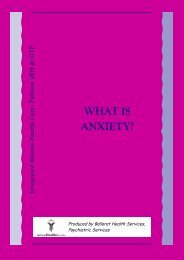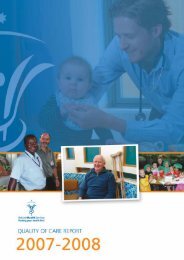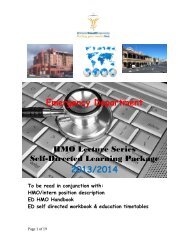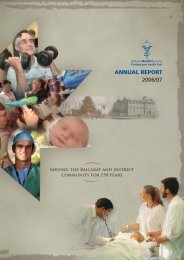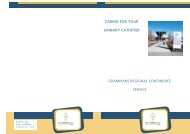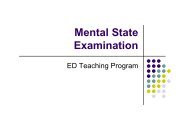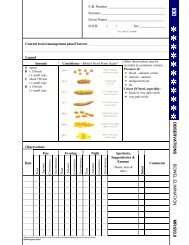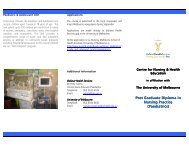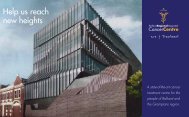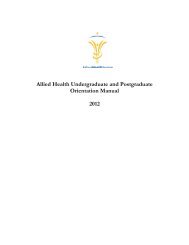Assessment of the Sick Child - BHS Education Resource
Assessment of the Sick Child - BHS Education Resource
Assessment of the Sick Child - BHS Education Resource
Create successful ePaper yourself
Turn your PDF publications into a flip-book with our unique Google optimized e-Paper software.
Paediatric <strong>Assessment</strong>:<br />
Recognition <strong>of</strong> <strong>the</strong> Unwell <strong>Child</strong><br />
Mark Hartnell<br />
2010<br />
Updated Jaycen Cruickshank Feb 2012
Aim - recognition <strong>of</strong> sick children<br />
• When you ask a consultant to come & look at<br />
a child – what’s <strong>the</strong> first thing <strong>the</strong>y do<br />
• (a) stick a tongue depressor in <strong>the</strong> mouth<br />
• (b) fiddle with <strong>the</strong> sats probe to get a trace<br />
• (c) check for testicular descent<br />
• (d) talk to <strong>the</strong> parents and watch <strong>the</strong> child<br />
• Nearly all <strong>of</strong> (d) is done subconsciously,<br />
quickly and I will outline one ‘formal’ way <strong>of</strong><br />
understanding it
Paediatric assessment triangle
Stand back!!! - APPEARANCE<br />
• MNEMONIC – TICLS<br />
• Tone<br />
• Interactiveness<br />
• Consolability (overlaps with irritability)<br />
• Look / Gaze (“glassy eyed”<br />
• Speech / Cry (high pitched, ‘cephalic’)<br />
• Level <strong>of</strong> alertness, somnolent, lethargic
Appearance<br />
• All <strong>of</strong> <strong>the</strong> above normal suggests at least<br />
adequate ventilation, oxygenation and brain<br />
perfusion<br />
• Ask <strong>the</strong> parents!!! What is normal<br />
• Watching interaction with parent can differentiate<br />
behaviour from illness<br />
• Inconsolable versus irritable<br />
• More difficult <strong>the</strong> younger <strong>the</strong> patient (Neonates<br />
can ‘startle’ and cry)
Truly “inconsolable” children<br />
• Hair tourniquet syndrome<br />
• Corneal ulcer<br />
• Testicular torsion<br />
• Meningitis<br />
• (colic and constipation)
Stand back!!! - Work <strong>of</strong> Breathing<br />
• Again best done from a distance<br />
• Crying makes oxygenation, ventilation and breath<br />
sounds difficult (airway OK though)<br />
• Abnormal posture & accessory muscles<br />
• Tripoding and ‘sniffing’ positions<br />
• Retractions, nasal flaring, head bobbing<br />
• Seesawing breathing<br />
• Listen for noises – grunting, stridor,<br />
wheezing, ‘snoring’
Stand back!!! - Work <strong>of</strong><br />
Breathing<br />
• There is a difference WOB & RATE<br />
• “effortless tachypnoea” = rapid RR but not<br />
increased effort and suggest breathing is<br />
NOT <strong>the</strong> problem<br />
• Usually compensation for eg. Acidosis<br />
• BUT really unwell children approaching<br />
respiratory FAILURE, WOB may decrease<br />
again (changes o<strong>the</strong>r parts <strong>of</strong> triangle)
Stand back!!! – circulation to skin<br />
• Young children have huge capacity to increase<br />
SVR shunting blood from skin to central organs<br />
• In compensated shock get initial pallor<br />
• pale child and rapid PR = shock TPO<br />
• Mottled skin <strong>the</strong>n occurs, random patterns <strong>of</strong><br />
vasoconstriction and vasodilation = ominous<br />
• NOT “cutis marmorata” (lacy marbling) and from cool<br />
(Ballarat) conditions<br />
• Cyanosis = late stage shock or resp failure
Paediatric assessment triangle<br />
• The three areas <strong>of</strong> <strong>the</strong> triangle can be used to<br />
determine which physiological ‘problem’ is<br />
present
STATE<br />
APPEARANCE<br />
WORK OF<br />
BREATHING<br />
CIRCULATION<br />
TO SKIN<br />
RESPIRATORY<br />
DISTRESS<br />
REPIRATORY<br />
FAILURE<br />
COMPENSATED<br />
SHOCK<br />
DECOMPENSATED<br />
SHOCK<br />
BRAIN INJURY /<br />
DUSFUNCTION<br />
CARDIORESP<br />
FAILURE<br />
NORMAL ABNORMAL NORMAL<br />
ABNORMAL ABNORMAL +/-<br />
NORMAL NORMAL ABNORMAL<br />
ABNORMAL +/- ABNORMAL<br />
ABNORMAL NORMAL NORMAL<br />
ABNORMAL ABNORMAL ABNORMAL
Neurological assessment<br />
• GCS 2 below normal
Hands on!! - Vital signs<br />
AGE RESP RATE PULSE<br />
12 12-16 60-100
BLOOD PRESSURE<br />
(LOWER LIMITS OF NORMAL)<br />
• NEONATAL 60<br />
• 1-12 MONTHS 70<br />
• THEN 70 + (AGE × 2) up to 10 years or so
Some final points:<br />
• 60 IS ALWAYS BAD!<br />
• BREATHING TOO FAST<br />
• BLOOD PRESSURE TOO LOW<br />
• PULSE TOO SLOW<br />
• No single number is as important as a trend<br />
over time<br />
• You won’t remember formulae, know where<br />
to look <strong>the</strong>m up, practice<br />
• They also only give a range



